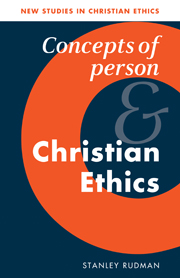Book contents
- Frontmatter
- Contents
- General editor's preface
- Acknowledgements
- List of abbreviations
- Introduction
- PART I ‘PERSON’ IN CONTEMPORARY ETHICS
- PART 2 ‘PERSON’ IN CHRISTIAN PERSPECTIVE
- 7 The relevance of history and Christology
- 8 Divine embodiment and temporality: is God a person?
- 9 Divine and human: relationality and personhood
- 10 Religion and morality: personhood, revelation and narrative
- PART 3 IMPLICATIONS FOR A CHRISTIAN ETHIC
- Conclusion
- Notes
- Select bibliography
- Index of subjects
- Index of names
9 - Divine and human: relationality and personhood
Published online by Cambridge University Press: 02 December 2009
- Frontmatter
- Contents
- General editor's preface
- Acknowledgements
- List of abbreviations
- Introduction
- PART I ‘PERSON’ IN CONTEMPORARY ETHICS
- PART 2 ‘PERSON’ IN CHRISTIAN PERSPECTIVE
- 7 The relevance of history and Christology
- 8 Divine embodiment and temporality: is God a person?
- 9 Divine and human: relationality and personhood
- 10 Religion and morality: personhood, revelation and narrative
- PART 3 IMPLICATIONS FOR A CHRISTIAN ETHIC
- Conclusion
- Notes
- Select bibliography
- Index of subjects
- Index of names
Summary
The analogy between divine and human personhood derives much of its strength from two different quarters: rationality and relationality. They are not incompatible. Either alone may give a skewed picture. Traditionally, however, rationality has been emphasised, in line with a long philosophical tradition which has also been influential in theology. This view would make personhood primarily a matter of rational qualities of soul and mind.1 Materiality and embodiment would be discounted. Relationality is much broader in its scope. It need not exclude rationality, but, in emphasising that individuality by itself omits a significant and distinctive feature of personhood, namely relationship with others, it also allows for embodiment and temporality to be taken into account. Rationality need not be interpreted narrowly as ‘discursive reason’ or ‘intelligence’, but should include the broader ‘capacity to decide and act freely’. Even so, the rational model remains too narrow. Relationality, which includes, not only the ability to communicate successfully with others and the qualities needed for such communication, but the simple fact of being in relationship, must form an important part of the total picture of personhood. This fact of ‘being in relationship’ will include, not only the foetus and the senile, but so-called inanimate nature. This will not involve an extension of ‘personhood’ to trees and mountains, but will allow the relationship of persons to trees and mountains to be taken into account when trying to understand personhood.
- Type
- Chapter
- Information
- Concepts of Person and Christian Ethics , pp. 171 - 189Publisher: Cambridge University PressPrint publication year: 1997



